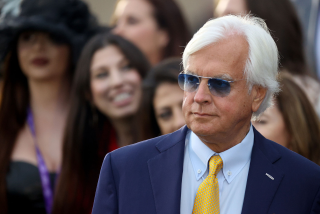Drug Use Said to Concern LeMond : Attorney Claims Dutch Team Wanted Cyclist to Try Testosterone
- Share via
Already beset by injuries and illness, Greg LeMond was further distressed last year because he feared his team, PDM of the Netherlands, would try to improve his lagging performances by tricking him into using a banned drug, the American cyclist’s attorney said Monday.
Although LeMond’s break with PDM, the sport’s dominant team, was primarily the result of a financial dispute, Ron Stanko of Reading, Pa., said the cyclist was believed to be out of the contract before this year because of his philosophical differences with the team’s officials regarding banned substances.
He said LeMond was particularly bothered by the team’s insistence that he use testosterone, a naturally produced male hormone that some cyclists believe will replenish their strength when injected into their systems. Cyclists are penalized if an excessive amount of testosterone is discovered in their urine samples during drug tests.
Stanko made the allegations in a telephone interview from Paris, where LeMond, representing the ADR team of Belgium, had made a remarkable comeback 24 hours earlier to win the Tour de France, the sport’s most prestigious race, for the second time since 1986.
LeMond, 28, was 50 seconds behind leader Laurent Fignon of France at the start of the final stage, a 15.2-mile individual time trial, but he erased that with eight seconds to spare in winning the closest of 76 tours.
LeMond had missed the two previous tours while recovering from a gunshot wound suffered in a hunting accident, an emergency appendectomy, a broken wrist and knee surgery.
“Their approach to the whole subject of hormones is like something from Mars,” Stanko said of PDM’s efforts to rehabilitate LeMond. “Their philosophy is that anything natural is permissible, even if it is acquired through artificial means.
“I had discussions with them myself, in which I explained to them that we were not interested in using chemicals to improve performances. That is Greg’s position, 100%.”
LeMond, who was in the Normandy town of Lisieux Monday, could not be reached for comment.
But Stanko said LeMond worried that PDM officials would not take no for an answer, believing they might try to put an anabolic steroid into his drink. Steroids are synthetic derivatives of testosterone that can be injected or swallowed.
“He never knew from one day to the next whether they would slip him something,” Stanko said.
Harry Jansen, a PDM spokesman, denied Stanko’s charges.
“He should watch what he says,” Jansen said by telephone from the Netherlands. “He might have a judicial problem.”
This is not the first time PDM has been linked to testosterone. Dutch newspapers reported last year that the team experimented with the substance earlier in 1988 to determine whether it would have a strength-enhancing effect.
Jansen said the experiment was sanctioned by the international professional cycling federation and involved 14 cyclists from several teams, including two from PDM. He said it was determined that testosterone did not enhance a cyclists’ performances.
In July, 1988, however, PDM’s Gert-Jan Theunisse of the Netherlands was penalized 10 minutes, effectively eliminating him from contention, and fined $750 when he tested positive for testosterone after winning a stage of the Tour de France.
Also in 1988, the eventual champion, Spain’s Pedro Delgado, tested positive after one stage for probenecid, a drug often used by athletes to mask the presence of banned substances in the system. Although probenecid was banned by the International Olympic Committee earlier that year, it had not yet been declared illegal in professional cycling.
Delgado, third in this year’s tour, rides for Spain’s Reynolds team, but he formerly was a PDM member.
Jansen said he considers the rumors and innuendo surrounding PDM a compliment. PDM had five cyclists among the top finishers in this year’s Tour de France, including Theunisse, who was fourth.
“I told my boss that we should be proud we hear criticism,” he said. “People are going to say many things about you, good and bad, when you are the best team in the world.”
But no one will deny that professional cycling has a drug problem despite extensive testing. In the Tour de France, the winner of each stage, two cyclists selected randomly and the overall leader are tested daily. No one tested positive this year, but tour officials said they presumed that there were drug users who were not caught.
“There were drugs in the Tour de France, no question about it,” Stanko said. “The question, as always, is who gets caught and who doesn’t. No one will ever convince me there weren’t people on drugs this year.”
Stanko, who also has represented track and field athletes, including hurdler Renaldo Nehemiah, said that sport has been the focus of worldwide attention because of its drug incidents, particularly the positive test for a steroid by sprinter Ben Johnson in the 1988 Summer Olympics. But Stanko said track and field is relatively clean compared to professional cycling.
“The American public is getting a taste of what the drug use is like in track and field,” he said. “But they haven’t even scratched the surface in that sport compared to what’s going on with the cyclists and their physicians. They are much more sophisticated at beating the tests. I would say that a good deal of what’s going on in track and field was learned from cycling.”
More to Read
Sign up for Essential California
The most important California stories and recommendations in your inbox every morning.
You may occasionally receive promotional content from the Los Angeles Times.













